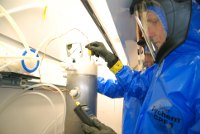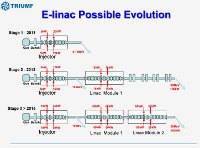 |
 |
|||||||||||||
|
|||||||||||||
|
|||||||||||||
|
Scientists at TRIUMF laboratory in Canada are wrapping up the design of a new experiment that will give them experience in building superconducting radiofrequency cavities and position them for further collaboration on the International Linear Collider. Canada is proposing to build an accelerator, called e-linac, that would reconstruct the reactions that took place after the Big Bang. The e-linac design uses SCRF cavities similar to those the ILC will use. “The ILC is a key element for the future of particle physics research in Canada,” said Dean Karlen, professor of physics, with a joint appointment at the University of Victoria and TRIUMF. “We need to develop the expertise for superconducting RF technology.” The e-linac measures in at 20 metres long, and will be made up of an electron gun and buncher cavity, followed by five 1.3 Ghz superconducting RF cavities. The intense electron beam within the machine will have initial currents up to 10 mA and energies of up to 50 MeV, all directed onto a target. It is this crucial target which will include a converter that produces photons as the electrons screech to a halt in the converter material. The photon beam is then directed onto another target, such as uranium, which produces neutron-rich isotopes through photo-fission. “Our project is all about understanding the universe,” said Nigel Lockyer, director of TRIUMF, “and knowing how the elements came about.” One of the most important parts of the e-linac is the compilation of all the SRF cavities. TRIUMF is now working together with PAVAC Industries, Inc., an electron-beam welding company in Canada and an industrial forum member of the ILC, to create the cavities and help the company build the skills needed to produce ILC cavities in the future. Fermilab has placed orders for single-cell cavities. “Having PAVAC Industries collaborate in producing 1.3 GHz SRF cavities gets us on track and gets us up to speed,” said Tim Meyer, head of TRIUMF strategic planning and communications. “It helps us develop the necessary technology.” Canada's experience in accelerator research is not new. It has made significant contributions in past years to the HERA accelerator at DESY, the Large Hadron Collider at CERN, and the neutrino beamline at J-PARC for the T2K experiment in Japan. The ILC as a large highe-energy machine could very well be the next step in R&D in Canada's portfolio of high-energy physics projects. Scientists at TRIUMF are in the final design stage of the e-linac project. They are making the single-cell 1.3 Ghz superconducting RF cavities and are also developing the target which the beam will strike to make the isotopes. This will allow scientists to then properly test and evaluate the cavities' interaction with the beam. “Canada recognises that together with the US, there will be a push forward to realise the many scientific benefits of a powerful ILC programme,” said Meyer. TRIUMF hopes to conduct a demonstration of the first phase of the machine by 2012 with beam delivery to an isotope-production target in 2013. -- Andre Sulluchuco |
|||||||||||||
| © International Linear Collider |

